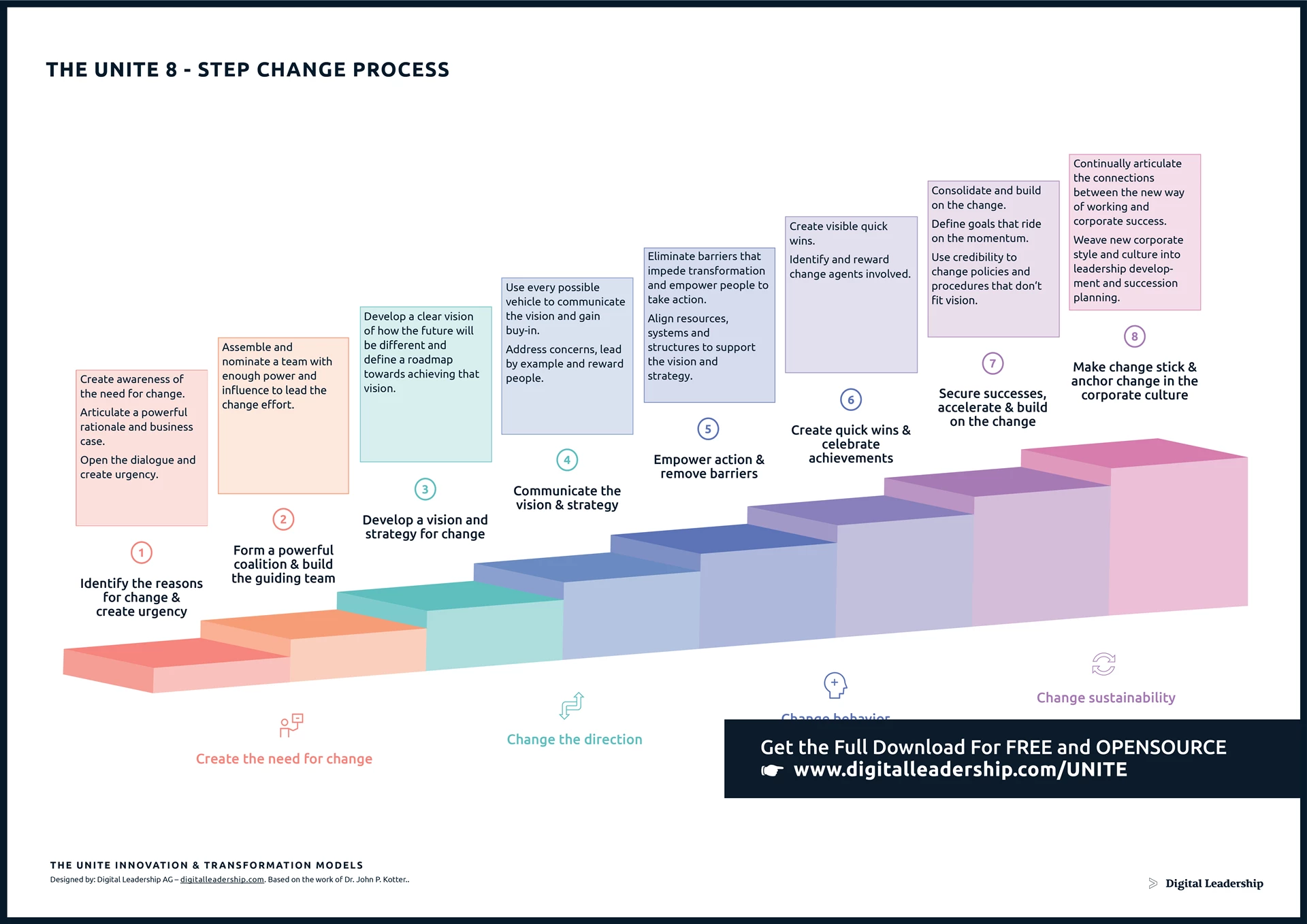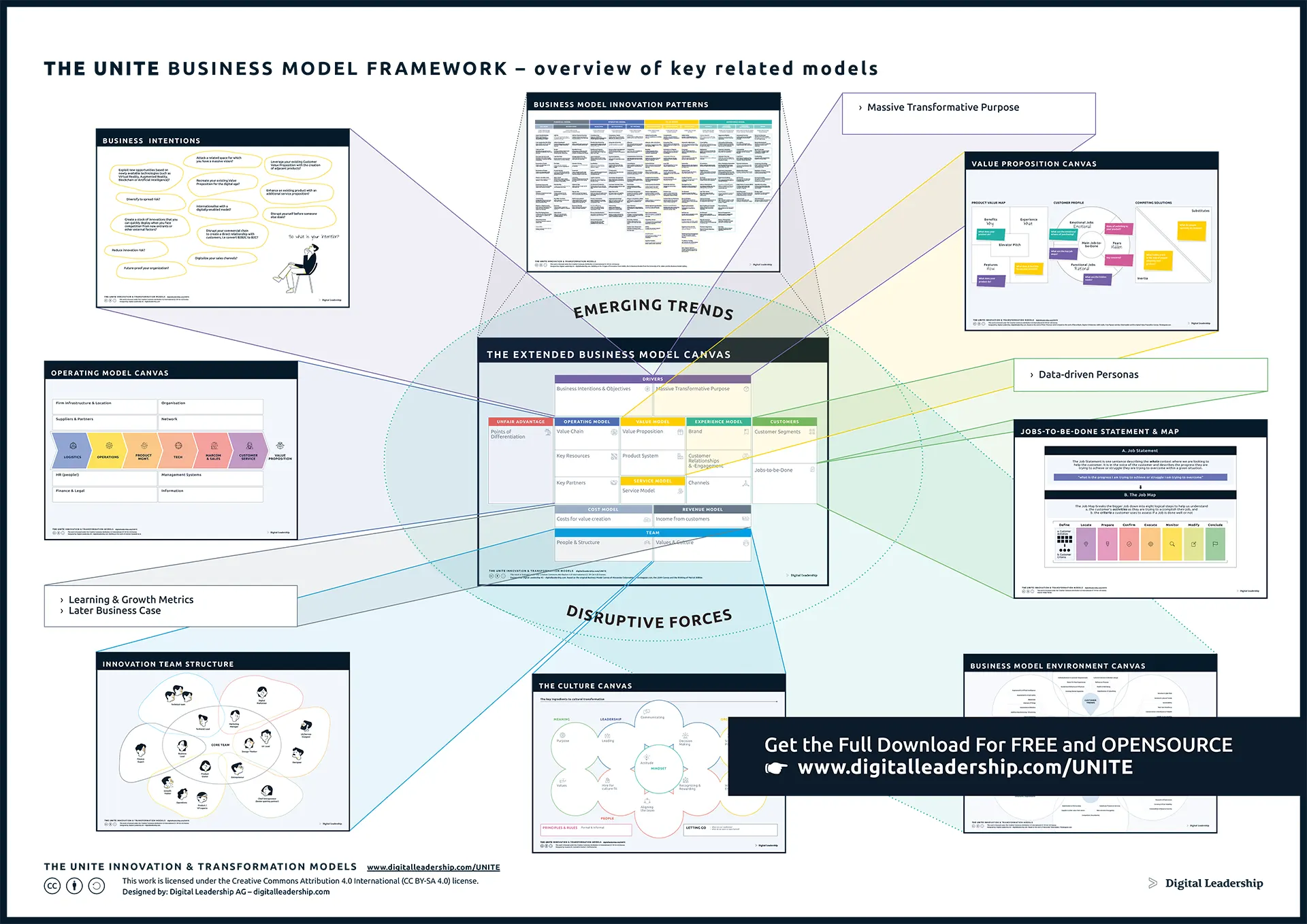Change Management Plan: What is it and How to Create Yours?
Published: 03 March, 2023
Organizational Development

Table of Contents
Plenty of businesses and business people claim they want to generate change in their companies and industries, but despite having big dreams, very few succeed. We believe the main reason these ventures fail is that they lack a Change Management Plan.
A Change Management Plan is an explicit description of how the different segments of a business will navigate innovation and transformation. The way we talk about change is often metaphorical, or aspirational. Your Change Management Plan will distil your vision into actionable processes that enable the advances you’re looking to make.
In this article, we will discuss how a Change Management Plan is an effective tool for innovation, and how you can use your own Plan as an engine for transformation and growth.
For a more complete discussion about various approaches to innovation strategy, read our brand-new FREE book “How to Create Innovation”, Register for the download now!
What is a Change Management Plan?
A change management plan is a structured approach that an organization follows to successfully introduce and manage changes within the company. It is typically used for significant or complex changes that have a significant impact on job roles and require a more strategic approach to implementation.
The plan outlines the steps necessary to transition from the current state to the desired future state and includes a plan for monitoring and measuring the success of the change.
One popular model for managing change is the 8-Step Change Model, which consists of eight steps that guide an organization through the process of implementing and managing change. The model begins with identifying the reason for change and gathering and analyzing data to understand the current situation.
It then moves on to developing a vision and strategy for the desired future state, communicating the change to stakeholders, empowering employees for success, creating a detailed plan for implementation, and executing the plan. Finally, the model includes a step for evaluating and adjusting the change as needed to ensure its success.
The 8-Step Change Model provides a structured approach for managing change and can be used in conjunction with a change management plan to ensure a smooth and effective transition.

Designed by: Digital Leadership AG – Based on the work of Dr. John P.Kotter
Change Management Importance
Change management plays a vital role in guiding organizations through the complexities of change, ensuring smooth implementation, and gaining stakeholder acceptance. At Digital Leadership, we specialize in providing customized strategic management and digital strategy consulting services tailored to meet the unique needs of businesses. Leveraging our expertise in digital technologies, we empower organizations to drive growth, elevate customer experiences, and achieve sustainable business outcomes.
Change management can help organizations to:
(1) Minimize resistance and increase support for change initiatives.
By having a well-structured change management plan, organizations can reduce resistance to change by effectively communicating the reasons for change and addressing potential concerns.
(2) Ensure that changes align with the organization’s overall strategy and goals.
A change management plan helps ensure that changes align with the overall business strategy and business goals and that the changes are aligned with the organization’s vision and mission.
(3) Enhance the effectiveness and success of change initiatives.
A change management plan helps organizations to implement changes more effectively and increases the chances of success.
(4) Minimize disruption to operations and minimize the impact of change on employees.
By effectively managing change, organizations can minimize the impact of change on employees and reduce disruption to operations, ensuring that the change process is smoother and more efficient.
(5) Improve communication and collaboration during the change process.
A change management plan helps improve communication and collaboration between different stakeholders during the change process, ensuring that everyone is working towards a common goal.
(6) Ensure sustainability of changes by embedding new practices into the organizational culture.
A change management plan helps organizations embed new practices into the organizational culture, ensuring that changes are sustained over time.
(7) Increase the chances of success by anticipating and addressing potential problems before they arise.
By anticipating and addressing potential problems before they arise, organizations can increase the chances of success and reduce the risk of failure.
How do you Write a Change Management Plan?
As you set to write a Change Management Plan, it’s important to remember why you’re writing it to begin with: you want to control the chaos that accompanies any major overhaul of an organization’s way of doing business. Managing the fear and uncertainty that people feel at this time will help change occur far more smoothly; having a clear roadmap of how you’ll bring that change to life is a big help.
Below we walk through the steps involved with writing a Change Management Plan that you can use to move your business forward.
Create the Need for Change
Step (1): Identify the Reasons for change & create urgency
- Create Awareness of the need for change
- Articulate a powerful rationale and business case.
- Open the Dialogue and Create Urgency
Step (2): Form a Powerful coalition and build the guiding team
Assemble and nominate a team with enough power and influence to lead the change effort
Change the Direction
Step (3): Develop a Vision & Strategy for Change
Develop a clear vision of how the future will be different and define a roadmap toward achieving that vision.
Step (4): Communicate the Vision and Strategy
- Use every possible vehicle to communicate the vision and gain buy-in
- Address concerns, lead by example, and reward people
Change Behavior
Step (5): Empower Actions & Remove Barriers
- Eliminate barriers that impede transformation & empower people to take actions
- Align resources, systems, and structures to support the vision and strategy
Step (6): Create Quick Wins & Celebrate Achievements
- Create visible quick wins
- Identify and Reward change agents involved
Change Sustainability
Step (7): Secure Successes, Accelerate & Build on the Change
- Consolidate and build on the change
- Define goals that ride on the momentum
- Use credibility to change policies and procedures that don’t fit the vision.
Step (8): Make Change Stick & Anchor Change in the Corporate Culture
- Continually articulate the connections between the new way of working & corporate success.
- Weave new corporate culture and style into leadership development and succession planning
Change Management Processes
Change management processes and systems pave the way for successful change management. It is important to be able to submit a change request, and then track, schedule, and manage that request through delivery. A change management system will allow a single storage location for all data associated with organizational changes, standardization of procedures, analysis of trends and activity, and easy access anywhere at any time.
Look for a system that offers the following functionality:
- Ability to break work down into tasks
- Configurable change request forms
- Budgeting and cost controls
- Change log for historical tracking
- Role assignment
- Configurable change management processes
- Schedule of changes (Forward Schedule of Change)
- Ability to classify as a change and reclassify as a defect
- Ability to change the assignment to individuals, teams, and/or Change Advisory or Change Control Board
- Updating changes
- Change monitoring
- Change approvals
Conclusion
Change is inevitable.
No marketplace survives intact forever, and successful businesses adapt as necessary to ensure their growth and prosperity. Additionally, businesses should change purposefully for innovation that makes better use of their resources and competitive advantage.
Following an articulated Change Management Plan will help guide your organization successfully through the decisions you make today for the opportunities you’ll find tomorrow.
The UNITE Business Model Framework: A Framework for Innovation Success

Designed By: Digital Leadership AG


































 Book How to Create Innovation
Book How to Create Innovation